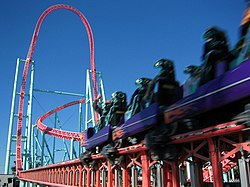Xcelerator
| Xcelerator | |
|---|---|
 |
|
| Knott's Berry Farm | |
| Park section | The Boardwalk |
| Coordinates | 33°50′45″N 118°00′03″W / 33.84583°N 118.00083°WCoordinates: 33°50′45″N 118°00′03″W / 33.84583°N 118.00083°W |
| Status | Operating |
| Opening date | June 22, 2002 |
| Cost | $25,000,000 |
| Replaced | Windjammer Surf Racers |
| General statistics | |
| Type | Steel – Launched |
| Manufacturer | Intamin |
| Designer | Werner Stengel |
| Model | Accelerator Coaster |
| Track layout | Dual Overbank Figure 8 |
| Lift/launch system | Hydraulic catch car launch |
| Height | 205 ft (62 m) |
| Length | 2,202 ft (671 m) |
| Speed | 82 mph (132 km/h) |
| Inversions | 0 |
| Duration | 1:02 (25 seconds from launch to brakes) |
| Max vertical angle | 90° |
| Capacity | 1,330 riders per hour |
| Acceleration | 0 − 82 mph (132 km/h) in 2.3 seconds |
| Height restriction | 52 in (132 cm) |
| Trains | 2 trains with 5 cars. Riders are arranged 2 across in 2 rows for a total of 20 riders per train. |
|
|
|
|
Xcelerator at RCDB Pictures of Xcelerator at RCDB |
|
Xcelerator is a steel launched roller coaster at Knott's Berry Farm in Buena Park, California. The ride was Intamin's first hydraulically launched coaster, while also the fourth Intamin installation at Knott's, alongside The Sky Cabin, Bigfoot Rapids, and Perilous Plunge (removed in 2012).
Xcelerator's powerful hydraulic catapult motor accelerates the train to 82 mph (132 km/h) in 2.3 seconds (about 1.62 g). It only uses 157 feet (48 m) of track to launch the train. The twin hydraulic catapult motor achieves a maximum of 10,500 horsepower (7,800 kW) each while accelerating the train. Xcelerator's hydraulic motor system has the mechanical capability of accelerating vehicles to a speed of 117 miles per hour (188 km/h) or more, though it only needs to hit 82. In order for a train to launch, it must "drift" back to "hook" into the catch car. Twenty-four volts are used to demagnetize a pin underneath the third car, causing it to drop. At the same time, two bellows actuators fill up with air, causing the two drive tires holding the train in place, at the train's rear, to retract. The brakes will lower while the train rolls back to hook, and the pin will then hook into the catch car—which is over 7 feet (2.1 m) long. Once connected, the motor will pull the catch car over nylon runners and launch the train. In order to stop the catch car, it passes over its own set of magnetic brakes. If the train is lightly loaded, the motor has to work harder to attain launch speed. Often the catch car may overshoot its ending position and down itself if it cannot attain the speed within parameters. The train must also clear the launch track within three seconds, or the ride will down itself and produce a shortshot. From the time the launch begins, the train has 8.25 seconds to pass over a proximity switch (Hall effect sensor) near the bottom of the first valley, thus clearing the starting block. If the train does not pass over the switch within the given time frame, the ride will down itself.
After launch, the train then crests a vertical 205 ft (62 m) top hat element (unlike rides such as Stealth at Thorpe Park, as its ascent is not vertical), then soars through a 110 ft and 95 ft over banked turns, and glides to a smooth stop over mounted magnetic brakes. The magnetic braking system consists of mounted magnetic clippers on the trains themselves and copper alloy fins mounted onto the track. The alloy fins on the launch section retract during the launching procedure so as to not interfere with the train. To slow the train in case of a rollback, they raise section by section after the train has passed them. The brake fins on the brake run are stationary and cannot be lowered. Vehicles are traveling at approximately 67 miles per hour (108 km/h) when entering the brake run.
...
Wikipedia
